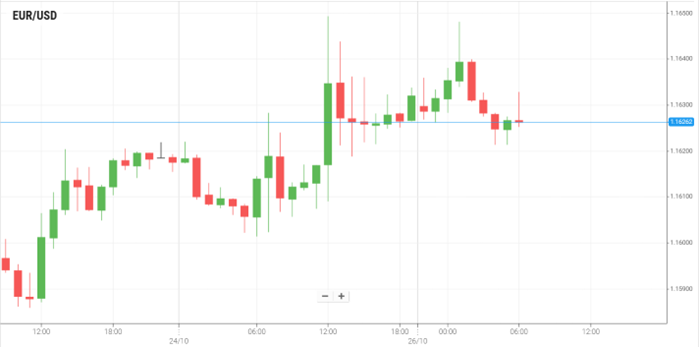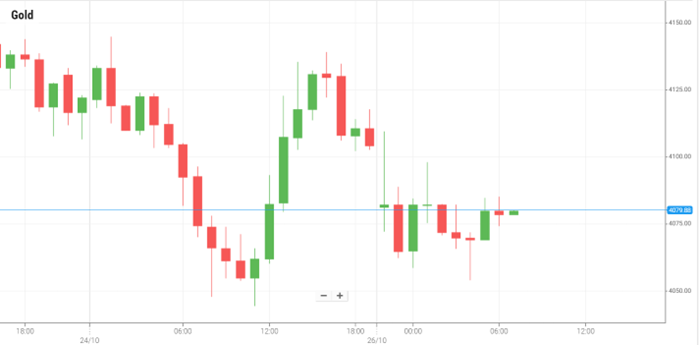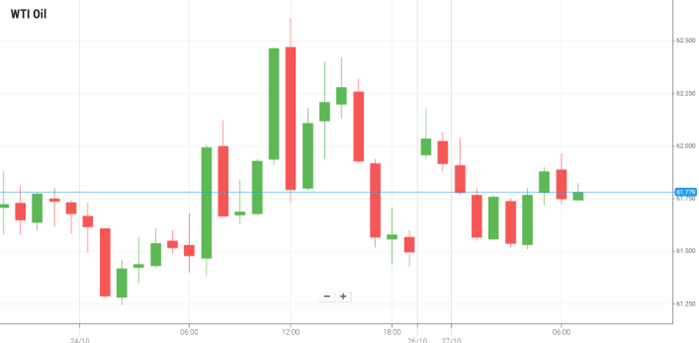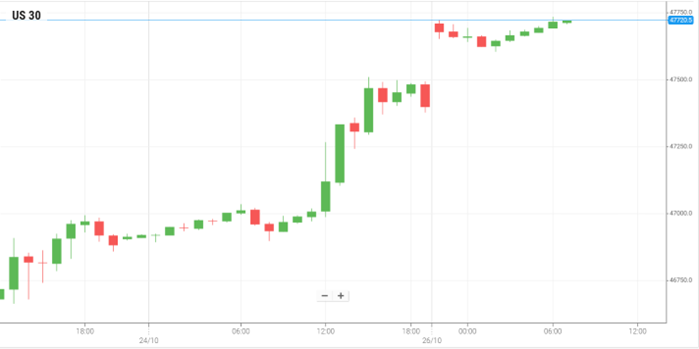This website uses cookies and is meant for marketing purposes only.
The USDX is trading on a negative note near 98.80 during Monday's early Asian session, softening despite posting a 0.54% gain last week. The dollar's current weakness is primarily due to the likelihood of an imminent Federal Reserve rate cut following last Friday's softer-than-expected US inflation figures. The Federal Reserve is widely expected to cut its benchmark rate by 25 basis points on Wednesday, a move reinforced by the September US Consumer Price Index (CPI) rising by 3.0% year-over-year, which came in below the 3.1% expectation. Market bets for another rate cut in December remain nearly fully priced in.
Meanwhile, Gold is trading with a negative bias for the second straight day, extending a downtrend that saw the precious metal log a -2.87% loss last week. Signs of easing trade tensions between the US and China continue to dent demand for the safe-haven asset, as evidenced by the upbeat mood in global equity markets. Top Chinese and US officials agreed on the framework of a potential trade deal over the weekend, with US Treasury Secretary Scott Bessent stating that the threat of 100% tariffs on Chinese imports starting November 1st has been eliminated. The focus now shifts to the crucial meeting between Presidents Trump and Xi later this week to finalize the deal framework. Despite the selling pressure, dovish Fed expectations and persistent geopolitical uncertainties are limiting deeper losses for Gold.
Asian equity markets rose sharply in broad-based buying on Monday, drawing strong support from a record-high finish on Wall Street last week. Sentiment was lifted by expectations of an imminent Federal Reserve interest rate cut and positive signals regarding US-China trade tensions. Chinese equities advanced following the preliminary trade framework reached by US and Chinese negotiators over the weekend in Kuala Lumpur. This agreement set the stage for a decision by Presidents Trump and Xi later this week, with US Treasury Secretary Scott Bessent confirming fresh tariff threats would be deferred. As of 06:09 AM GMT, the China SSE rose 1.09%, the China SZSE climbed 1.46%, and the Hong Kong 50 advanced 0.69%. Japanese shares extended their record rally, with the Japan 225 up 0.86% and the Japan 100 gaining 0.31% as of 06:10 AM GMT. The Nikkei surpassed the 50,000-point mark for the first time. Investor optimism persists, rooted in the expectation that new Prime Minister Senae Takaichi, who is viewed as fiscally dovish, will push for additional stimulus measures focused on inflation relief and sustaining recovery.
In corporate news, Baidu shares jumped in Hong Kong, fueled by optimism over the international expansion of its robotaxi unit, Apollo Go. This follows the company's announcement of a partnership with Switzerland's PostBus to launch its robotaxis in Europe. Baidu posted a 1.88% gain on Friday (in U.S. trading). Baidu peer Alibaba also saw its shares rise after Ark Invest disclosed buying more shares in the e-commerce giant. Ark is demonstrating growing confidence in Chinese tech stocks due to their artificial intelligence prospects. Alibaba logged a 1.57% gain on Friday (in U.S. trading).
The main US equity indices tracked a record-high finish last week. Markets are largely factoring in a 25-basis-point rate reduction by the Federal Reserve at the end of its two-day meeting on Wednesday, following softer-than-expected US inflation data for September. Traders are now looking to the Fed for guidance on the timing and size of further cuts. Risk sentiment was further buoyed by the progress in US-China trade talks, with President Trump stating on Sunday, "I think we’re going to have a deal with China.”
Attention will now shift to corporate earnings this week, with five of the so-called “Magnificent Seven” tech giants scheduled to report. Microsoft, Meta Platforms, and Alphabet (Google's parent company) are due to release results on Wednesday, followed by Apple and Amazon on Thursday.
The EUR/USD pair ended the week down 0.33%, but managed to post minor gains on Friday as recent US data failed to shift expectations that the Federal Reserve will move forward with a rate cut in October.
September’s US Consumer Price Index (CPI) came in slightly below expectations, rising 3.0% year-over-year versus forecasts of 3.1%. The core CPI, which excludes food and energy, eased to 3.0% from 3.1% in August — still well above the Fed’s 2% target but showing mild disinflationary progress.
The weaker-than-expected reading strengthened market bets on a 25-basis-point rate cut, with FedWatch data showing a 96% probability of an October move. Traders are also pricing in an additional quarter-point reduction in December, which would bring rates down to the 3.75%–4.00% range.
Meanwhile, the University of Michigan’s Consumer Sentiment Index was revised lower to 53.6 from an initial 55.0, as households turned slightly more cautious. Short-term inflation expectations edged down to 4.6%, while the five-year outlook ticked up to 3.9%.
In Europe, the HCOB Flash PMIs for October surprised to the upside, suggesting an improving economic backdrop
The data indicate a return to expansion in manufacturing and stronger momentum in services, providing support for the euro. However, gains were capped after Moody’s Ratings downgraded France’s outlook to negative, citing fiscal slippage and political uncertainty as key risks.
With US inflation easing and Eurozone data showing tentative recovery, EUR/USD is likely to remain rangebound around 1.1600 in the near term. Attention now turns to next week’s Federal Reserve meeting, where policymakers are expected to confirm the long-anticipated rate cut.

Gold prices retreated early on Monday as a firmer U.S. dollar and signs of progress in U.S.-China trade talks reduced demand for the safe-haven asset. Investors are also adopting a cautious stance ahead of several major central bank policy meetings scheduled later this week.
The U.S. dollar climbed to a two-week high against the yen, extending its recent recovery and making gold more expensive for holders of other currencies. A stronger greenback typically weighs on the yellow metal by reducing its appeal as an alternative investment.
The move came as investors responded to encouraging signs of de-escalation between the world’s two largest economies. Over the weekend, senior U.S. and Chinese economic officials reportedly agreed on a framework for a potential trade deal, which could be finalized when Presidents Donald Trump and Xi Jinping meet later this week.
Market participants are now focused on the upcoming Federal Reserve meeting on Wednesday, where policymakers are widely expected to cut interest rates by 25 basis points. Friday’s softer-than-expected U.S. inflation report has reinforced the case for easing.
With the rate cut largely priced in, traders will closely watch Fed Chair Jerome Powell’s comments for clues about the path of future policy. Lower interest rates tend to support gold, which does not yield interest, by reducing the opportunity cost of holding the metal.

Oil prices advanced in Asian trading on Monday, buoyed by renewed optimism over U.S.-China trade negotiations and easing concerns about a near-term global supply glut. Additional support came from fresh U.S. sanctions on Russia’s oil industry, while expectations for lower U.S. interest rates further underpinned sentiment.
Crude prices strengthened after U.S. and Chinese officials reached a framework trade agreement ahead of a planned meeting between President Donald Trump and President Xi Jinping later this week. The potential deal is expected to include reduced Chinese export curbs on rare earths and increased U.S. agricultural imports, particularly soybeans, according to reports from U.S. officials.The two leaders are scheduled to meet on Thursday in South Korea, following high-level discussions between U.S. and Chinese delegations at the ASEAN Summit in Malaysia over the weekend.
Oil’s rally also extended from last week, when the United States imposed new sanctions targeting Russia’s two largest oil producers, Lukoil and Rosneft. The measures aim to pressure Moscow into a ceasefire with Ukraine, but analysts remain skeptical about their effectiveness given Russia’s historical ability to circumvent previous sanctions through alternative trade channels.
The market’s focus now turns to how key Russian oil buyers, including India and China, will respond to U.S. pressure to scale back purchases of Russian crude.
Oil markets also drew support from growing expectations of a Federal Reserve rate cut this week, following weaker-than-expected U.S. inflation data released on Friday. Lower interest rates typically boost demand for commodities, including oil, by easing financing conditions and weakening the U.S. dollar.

The us 30 closed above 47,000 for the first time ever on Friday, as softer inflation data reinforced expectations that the Federal Reserve will cut interest rates next week.
Newly released inflation figures showed that price pressures in the U.S. economy continued to ease in September. The Consumer Price Index (CPI) rose 3.0% year-on-year, slightly below economists’ expectations of 3.1%, while the monthly reading came in at 0.3%, also below forecasts. The core CPI, which excludes volatile food and energy prices and is closely monitored by the Fed, rose 3.0% annually and 0.2% month-on-month — both softer than anticipated.
Intel (NASDAQ: INTC) shares jumped after the chipmaker posted better-than-expected third-quarter earnings, driven by aggressive cost-cutting initiatives. The results marked Intel’s first quarterly report following major investments from Nvidia (NASDAQ: NVDA), Japan’s SoftBank, and an unprecedented U.S. government equity stake, fueling optimism for a substantial liquidity boost. Ford (NYSE: F) also advanced after reporting quarterly profits that topped expectations, supported by robust demand for SUVs and pickup trucks. Meanwhile, Target (NYSE: TGT) announced plans to cut about 1,800 corporate roles, or roughly 8% of its global headquarters workforce, as part of a sweeping restructuring effort. Looking ahead, investors will turn their attention to next week’s earnings releases from five of the “Magnificent Seven” tech giants, including Apple (NASDAQ: AAPL) and Microsoft (NASDAQ: MSFT).

The materials contained on this document should not in any way be construed, either explicitly or implicitly, directly or indirectly, as investment advice, recommendation or suggestion of an investment strategy with respect to a financial instrument, in any manner whatsoever. Any indication of past performance or simulated past performance included in this document is not a reliable indicator of future results. For the full disclaimer click here.
Join iFOREX to get an education package and start taking advantage of market opportunities.